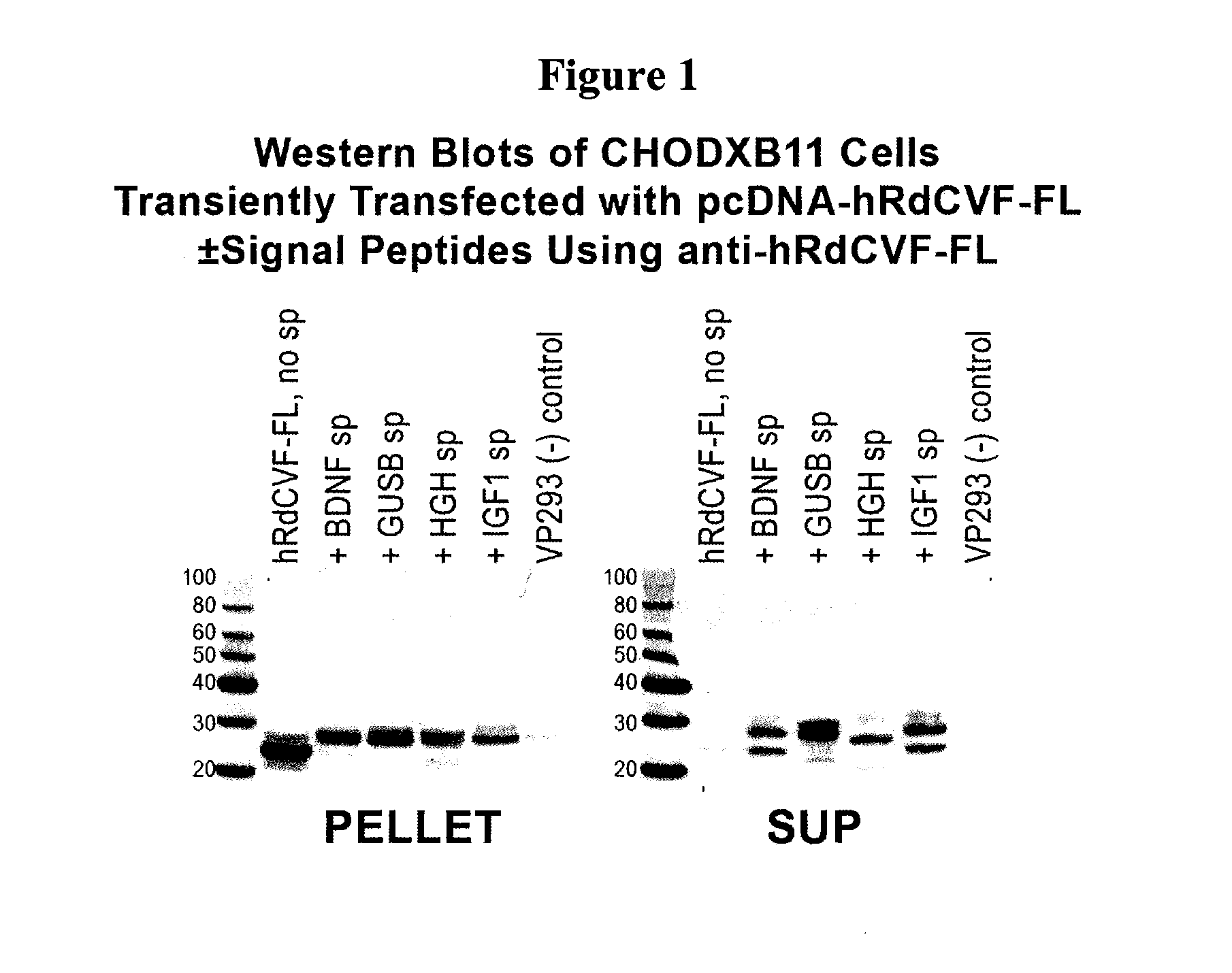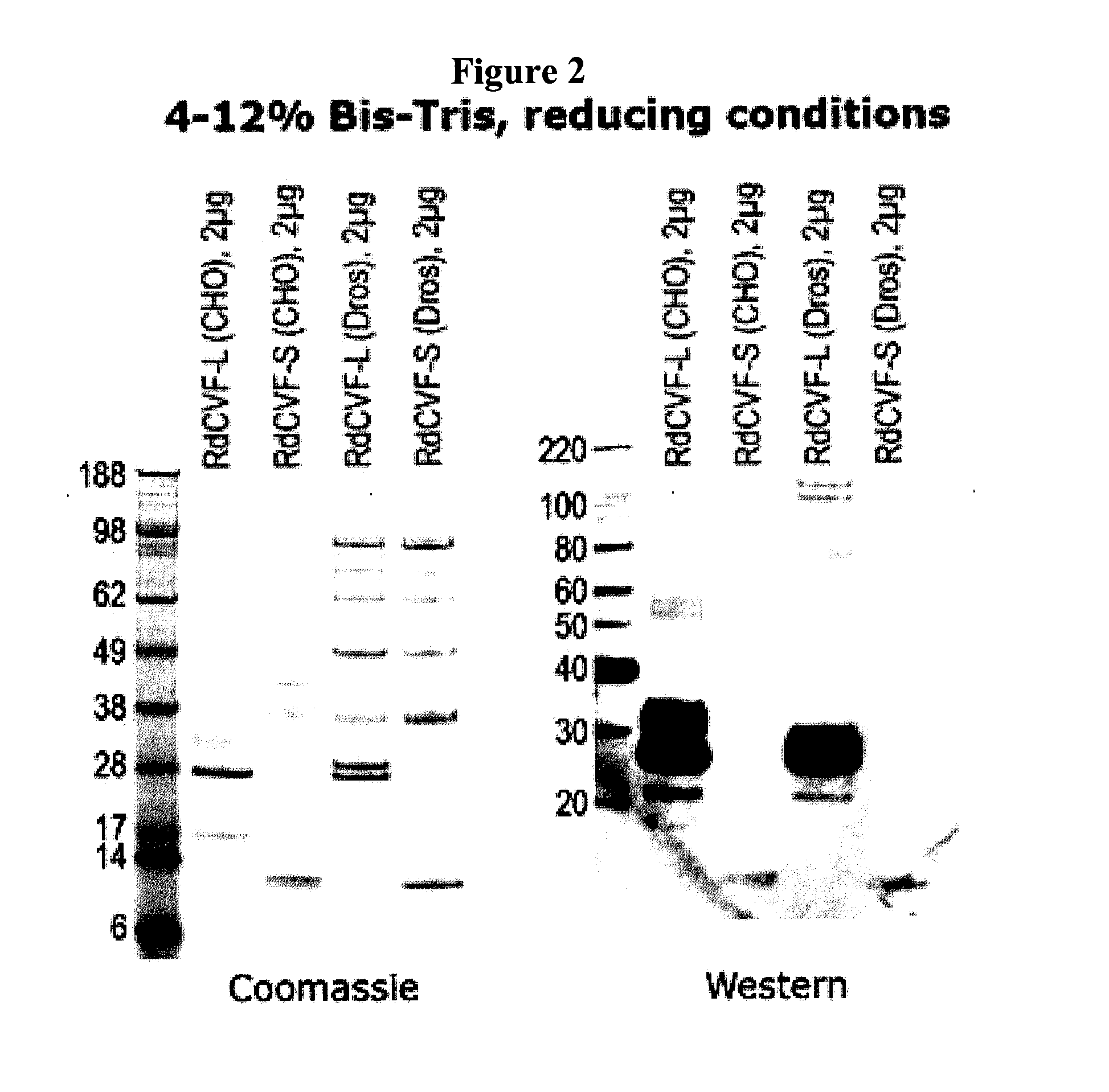Methods to produce rod-derived cone viability factor (RDCVF)
a technology of viability factor and rod-derived cone, which is applied in the field of producing rod-derived cone viability factor (rdcvf) using engineered cells, can solve the problems of large-scale recombinant expression of rdcvf and the difficulty of effective expression of rdcvf from a gene therapy vector
- Summary
- Abstract
- Description
- Claims
- Application Information
AI Technical Summary
Benefits of technology
Problems solved by technology
Method used
Image
Examples
example 1
Generation of cDNAs Encoding RdCVF with Different Signal Peptides
[0089]Expression vectors were constructed to evaluate the efficiency of RdCVF expression using a number of signal peptides. Signal peptides from brain derived neurotrophic factor (BDNF), insulin growth factor 1 (IGF1), and beta-glucoronidase signal peptide (GUSB) were evaluated.
[0090]In the case of these signal peptides, the relevant sequences were cloned immediately before the initiating methionine for RdCVF. In FIGS. 5-10, the signal peptide sequence (depicted in bold in the following sequences) is followed by an amino acid linker sequence (depicted by underline) followed by a furin cleavage site depicted in italics. The remainder of the sequence indicates the amino acid sequence for RdCVF (Short Form or Long Form). The different signal peptides are cleaved by their respective signal peptidases in the ER (specific site depicted by arrow). Inclusion of the furin cleavage site KRIKR, results in removal of the remaining...
example 2
Human Growth Hormone Signal Peptide LONG FORM Human RdCVF
[0091]Expression vectors were constructed to evaluate the efficiency of RdCVF expression using the signal peptide from HGH signal peptide (Human growth hormone signal peptide). For the HGH signal peptide, the cDNA construct is designed such that the initiating methionine for RdCVF is removed resulting in a RdCVF protein that initiates with an Alanine.
[0092]In FIGS. 11 and 12, the signal peptide sequence is depicted in bold in the following sequences. The remainder of the sequence indicates the amino acid sequence for RdCVF (Short Form or Long Form). The signal peptide is cleaved by the respective signal peptidase in the ER (specific site depicted by arrow).
example 3
Human Growth Hormone Signal Peptide LONG FORM Human RdCVF HPC4 Tag
[0093]As in Example 2, expression vectors were constructed to evaluate the efficiency of RdCVF expression using the signal peptide from HGH signal peptide (Human growth hormone signal peptide) that contain a purification tag. For the HGH signal peptide, the cDNA construct is designed such that the initiating methionine for RdCVF is removed resulting in a RdCVF protein that initiates with an Alanine. In FIGS. 13 and 14, the signal peptide sequence is depicted in bold. The remainder of the sequence indicates the amino acid sequence for RdCVF (Short Form or Long Form). The signal peptide is cleaved by the respective signal peptidase in the ER (specific site depicted by arrow). The twelve amino acid HPC4 tag is depicted by underline.
PUM
| Property | Measurement | Unit |
|---|---|---|
| concentration | aaaaa | aaaaa |
| concentration | aaaaa | aaaaa |
| concentration | aaaaa | aaaaa |
Abstract
Description
Claims
Application Information
 Login to View More
Login to View More - R&D
- Intellectual Property
- Life Sciences
- Materials
- Tech Scout
- Unparalleled Data Quality
- Higher Quality Content
- 60% Fewer Hallucinations
Browse by: Latest US Patents, China's latest patents, Technical Efficacy Thesaurus, Application Domain, Technology Topic, Popular Technical Reports.
© 2025 PatSnap. All rights reserved.Legal|Privacy policy|Modern Slavery Act Transparency Statement|Sitemap|About US| Contact US: help@patsnap.com



